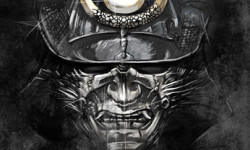Hardly any other war like the Gempei war had such far-reaching effects on Japanese society and military sentiment.
In Japan, in the 12th century, so-called "clans" had formed, which were the secret rulers on the island and based their power on the legendary samurai warriors who were subject to them. The emperor played at this time only a minor role.
The conflict smoldering for generations between the clans of Minamoto and Taira finally escaped in 1156 in a major civil war. In 1177, the Taira prevailed and established the first Samurai government of Japan. Their reign, the Taira but could hold only 3 years until again the clan of Minamoto sought the power. After the Taira could force the emperor Takakura to abdicate, they put the 1 year old grandson of Taira no Kiyomori on its place. The Prince Mochihito, puppet of the Minamotos, felt so disadvantaged as half-brother Takakura in the succession of the throne, which earned him the order of capture by Taira no Kiyomori. On the run, Prince Mochihito was killed, his companion Minamoto Yorimasa escaped capture by suicide. This "Seppuku", ie honorable suicide, had henceforth a firm place in the code of the samurai.
Minamoto Yoritomo now took the lead over the Minamoto clan, followed by a series of bouts whose final decision in 1185 at the Battle of Dan-no-Ura was sealed by the Minamoto's victory over the Taira. The power of the Taira has now been destroyed once and for all.
In 1192, the emperor named Go-Toba Yorimoto a shogun (commander-in-chief). By this step, the real power of Japan was now in the hands of the Minamoto. The shoguns existed, except for brief interruptions, until the second half of the 19th century.
Another, lasting and longer-lived effect of the Gempei war was Japan's military culture following the Samurai Code, which would last until the end of the Second World War.
You can find the right literature here:
The Gempei War 1180–85: The Great Samurai Civil War
Internationally renowned samurai expert Dr. Stephen Turnbull delves into a pivotal era of Japanese history in this highly illustrated account of the Gempei War, a conflict that defined the age and the ethos of the samurai.
Never before had there been a large-scale clash between two rival samurai families, the Taira and the Minamoto, and never again would the result of a war in Japan be quite so dramatic. Fought to gain control over the emperor, it would end with imperial power being totally eclipsed in favor of the military might of the samurai class and the establishment of the position of shogun--Japan's military dictator. Turnbull examines the events of the five-year-long conflict, revealing the changes that the war inflicted on Japanese culture and how it establishmened many samurai traditions.
Samurai, Warfare and the State in Early Medieval Japan
Karl Friday, an internationally recognised authority on Japanese warriors, provides the first comprehensive study of the topic to be published in English. This work incorporates nearly twenty years of on-going research and draws on both new readings of primary sources and the most recent secondary scholarship.
It overturns many of the stereotypes that have dominated views of the period. Friday analyzes Heian -, Kamakura- and Nambokucho-period warfare from five thematic angles. He examines the principles that justified armed conflict, the mechanisms used to raise and deploy armed forces, the weapons available to early medieval warriors, the means by which they obtained them, and the techniques and customs of battle.
A thorough, accessible and informative review, this study highlights the complex casual relationships among the structures and sources of early medieval political power, technology, and the conduct of war.
Japanese Fortified Temples and Monasteries AD 710-1602
From the 10th century onwards the great Japanese monastic foundations of Nara and Mount Hiei maintained large armies of warlike monks. The tempestuous political rivalries that developed between the different orders of monks and religiously inspired laymen ensured that their temples and monasteries had to be securely sited and robustly defended. This books recreates these enormous fortified monasteries and temples, tracing their development from the 10th century through to the Sengoku Jidai period and the rise of the power of the shogunate under Tokugawa Ieyasu.
This post is also available in:
 Deutsch (German)
Deutsch (German)  Français (French)
Français (French)  Italiano (Italian)
Italiano (Italian)  简体中文 (Chinese (Simplified))
简体中文 (Chinese (Simplified))  Русский (Russian)
Русский (Russian)  Español (Spanish)
Español (Spanish)  العربية (Arabic)
العربية (Arabic)















